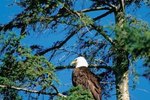
Minks and weasels are members of the mustelid animal family. Mustelidae share a few basic characteristics. One commonality among mustelids is the possession of anal scent glands that release a musty substance the animals use for defense and territorial marking. Weasels, minks and other Mustelidae -- including martens, fishers, ferrets, polecats, wolverines and badgers -- differ in size, habitat and diet; but all are carnivores, and most are aggressive and seemingly fearless animals.
Size
American minks are larger and heavier than North American weasel species, such as the least weasel, the long-tailed weasel and the short-tailed weasel or ermine. Minks are long, slender mammals with long necks and short legs. Adult male minks weigh up to 3.5 pounds and are 20 to 30 inches long, tails included. Adult female minks are two-thirds the size of males. They grow 16 to 21 inches long and weigh 1.5 to 2 pounds. Adult male weasels’ range in size from 3 ounces and less than 10 inches long to 16 ounces and up to 16 inches long. Female weasels weigh from 1 ounce to 9 ounces and measure 6 to 14 inches in length, depending on species.
Fur and Appearance
Minks are slender mammals with pointed noses, short legs and partially webbed feet. Weasels are also long and slender, with short legs and long snouts; but their feet are not webbed. Some weasels have long tails and others have short tails. Minks' long tails are bushy and fur-covered; and their soft, thick, waterproof fur is dark brown to almost black, except for around their throats and chins, which are white, and their white-spotted stomachs. Minks' thick undercoats provide buoyancy and insulation. Weasel fur is brown to yellowish-brown, with paler fur on the neck and belly. Northern weasels, such as ermines, molt in autumn and grow pure white fur by winter. The white fur molts in spring, and their brown coats return. Weasels living further south maintain brown fur all year. Unlike weasels, minks' fur does not change color.
Diet

Weasels attack and occasionally kill prey much larger than themselves, such as rabbits, squirrels, rats, woodchucks, piglets, chickens and snakes. They also eat birds, eggs, insects and small rodents. Using the prey's own tunnels to track them, weasels catch and kill their victims, including moles, voles and mice. Mink are aggressive predators, able to attack and kill animals larger than they are, such as rabbits and large birds. Their diet includes rodents, eggs, birds, frogs, fish and crayfish. After killing prey, minks carry food to solitary dens to eat or save for later. Mink stalk shorelines, riverbanks and wetlands, hunting whenever prey is available. They swim fast and can dive 15 feet underwater to catch muskrats, their favorite food.
Habitat

Minks live in wetland habitats, including streams, rivers, lakes, ponds and marshes. They need access to reliable sources of water for drinking and hunting, and shoreline vegetation for camouflage during frequent food-finding forays. Minks travel along miles of stream habitat and over acres of wetlands, where they find abandoned dens to burrow in, especially during harsh winter weather. Weasels live in a variety of habitats, including woodlands, brush and fields. They also need drinking water nearby -- but, unlike minks, weasels do not swim or seek prey in water, and their range is less extensive than the minks'. Weasels establish dens in hollow trees, logs and other protected places, lining their homes with grass, leaves, feathers and fur.
References
- Wildlife Online: Order Carnivora, Family Mustelidae: Weasels, Minks, Otters, Badgers, Wolverines, Skunks
- Vermont Fish & Wildlife Department: Furbearer Species
- Michigan Wildlife Conservancy: The Mustelids of Michigan - Hey, You Little Weasel!
- Enchanted Learning: Mink
- Enchanted Learning: Weasel
- Wildlife Response: Mink and Weasel Family
- Maryland Department of Natural Resources: Maryland's Mustelids
- Nebraska Game and Parks Commission: Mink
- A-Z Animals: Weasel
Photo Credits
-
Hemera Technologies/Photos.com/Getty Images
Writer Bio
Maura Wolf's published online articles focus on women, children, parenting, non-traditional families, companion animals and mental health. A licensed psychotherapist since 2000, Wolf counsels individuals struggling with depression, anxiety, body image, parenting, aging and LGBTQ issues. Wolf has two Master of Arts degrees: in English, from San Francisco State University and in clinical psychology, from New College.



